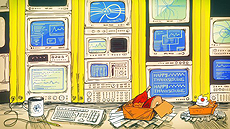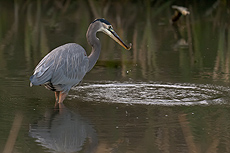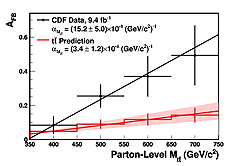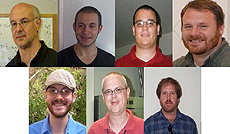|
Thursday, Nov. 29
- Breakfast: Greek omelet
- Chicken noodle soup
- Barbecue chopped-pork sandwich
- Southern fried chicken
- Smart cuisine: Stir-fried vegetables
- Italian loaf sandwich
- Assorted pizza by the slice
- Tex-Mex grilled-chicken salad
Wilson Hall Cafe Menu |
|
Friday, Nov. 30
Dinner
- Clam chowder
- Grilled lamb chops with balsamic glaze
- Stuffed tomatoes with pesto
- Julienne of zucchini
- Amaretto cheesecake
Wednesday, Dec. 5
Lunch
- Cajun jambalaya (shrimp, chicken and andouille sausage)
- Mixed-green salad
- Sour-cream lemon pie
Chez Leon Menu
Call x3524 to make your reservation.
|
|
Thanksgiving in the Main Control Room
 |
The daughter of the Tevatron particle collider's Mr. Fix-It continues a tradition of providing cheer for operators stuck at work on the holiday. Image: Sandbox Studio
|
Particle colliders do not keep normal working hours. They must be tended to 24 hours a day, seven days a week, holidays included.
Few people know this as well as the family of Robert "Obie" Oberholtzer, a talented engineer whom crews at Fermilab would call—any day, any time—when something went wrong with the accelerator complex for the laboratory's particle collider, the Tevatron.
"Let me put it this way," says his daughter Jennifer Oberholtzer, now 43. "They called him in to work even the day I gave birth to my daughter ... He got to visit the hospital for a little while, at least."
Oberholtzer worked at Fermilab for 41 years. He earned a reputation as someone who knew the machines inside and out (he could diagnose a problem sometimes by sound alone), as someone who kept his cool under pressure (he once responded to a control panel bursting into flames with a slow shake of the head and a calmly muttered swear), and as a particularly tough pitcher in the laboratory's softball league.
Despite all of the times the Tevatron crew disrupted his sleep, made him miss his Ohio State football games and deprived him of dinner, Oberholtzer thought of them as a second family.
So when he began volunteering with an organization that provided Thanksgiving meals to people who might otherwise spend the holiday alone, he thought of the operators stuck on shift.
Read more
—Kathryn Jepsen
|
Environment, Safety & Health Fair - today on the 15th floor
The ES&H Section will hold a laboratorywide fair today from 11:30 a.m. to 1 p.m. on the 15th floor. Topics include winter sports safety, traffic safety, heating hazards and holiday safety. There will be raffles and giveaways to make your winter safe for you and your family.
|
Pages from the great blue heron photo flipbook
 |
A great blue heron goes fishing in the pond that feeds Swan Lake, just west of Wilson Hall. Marty Murphy, AD
|
|
High-energy physicists smash records for network data transfer
From Caltech News, Nov. 21, 2012
PASADENA, Calif.—Physicists led by the California Institute of Technology (Caltech) have smashed yet another series of records for data-transfer speed. The international team of high-energy physicists, computer scientists, and network engineers reached a transfer rate of 339 gigabits per second (Gbps)—equivalent to moving four million gigabytes (or one million full length movies) per day, nearly doubling last year's record. The team also reached a new record for a two-way transfer on a single link by sending data at 187 Gbps between Victoria, Canada, and Salt Lake City.
The achievements, the researchers say, pave the way for the next level of data-intensive science—in fields such as high-energy physics, astrophysics, genomics, meteorology, and global climate tracking. For example, last summer's discovery at the Large Hadron Collider (LHC) in Geneva of a new particle that may be the long-sought Higgs boson was made possible by a global network of computational and data-storage facilities that transferred more than 100 petabytes (100 million gigabytes) of data in the past year alone. As the LHC continues to slam protons together at higher rates and with more energy, the experiments will produce an even larger flood of data – reaching the exabyte range (a billion gigabytes).
Read more |
|
Symmetries are important
 |
The image above shows the top-antitop rapidity difference (top)
and the forward-backward asymmetry as a function of the top quark pair invariant mass (bottom) after correcting for event selection and detector effects. The data, shown in black, contains an asymmetry that exceeds what is predicted by current Standard Model calculations, shown in red.
|
Past analyses by scientists at CDF and DZero have shown hints of an unexpectedly large forward-backward asymmetry in the production of top quark pairs during Tevatron collisions. A new measurement at CDF using the full Tevatron data set confirms this asymmetry and uses new techniques to study the dependence of the asymmetry on the properties of the top-antitop system, providing new information about the effect and how it compares to theoretical predictions.
Symmetry is fundamental to the theories that describe elementary particle interactions. A discrepancy from a predicted symmetry or asymmetry can be an important clue pointing
to the presence of new physical processes or the need for revision of existing theoretical calculations.
The new result from CDF looks at the direction of motion of the outgoing top quark using a variable called rapidity and determines how often the top quark travels along the direction of the colliding proton (forward) or antiproton (backward).
Only a portion of the top quark pair events produced during collisions inside the CDF detector are actually observed and recorded by the detector, and even in events that do get recorded, sometimes the measured direction of motion of a top quark does not correspond exactly to its true direction of motion. This analysis introduces new techniques to correct for these effects in order to measure the "parton level" asymmetry—that is, the true asymmetry in all top quark events before the influence of experimental effects. The size of the asymmetry is found to be 16.4 ± 4.5 percent, compared to a Standard Model prediction of approximately 7 percent. It is seen to grow approximately linearly as Mtt and |Δy| increase.
The slopes of linear fits to the data are used to compare this mass- and rapidity-dependent behavior to the Standard Model expectations. CDF finds that the slopes exceed the predictions with a significance above 2 sigma, confirming the previous measurements and providing important information about possible new physical interactions or improvements that must be made to existing theoretical predictions.
—edited by Andy Beretvas
Learn more
 |
| These CDF physicists contributed to this data analysis.
Top row from left: Dan Amidei, Ryan Edgar, Dave Mietlicki, Tom Schwarz, all from the University of Michigan.
Bottom row from left: Jon Wilson, Tom Wright, both from the University of Michigan, and Joey Huston from Michigan State University.
|
|
US science could face fiscal cliff doom
From Discovery News, Nov. 25, 2012
The American science programs that landed the first man on the moon, found cures for deadly diseases and bred crops that feed the world now face the possibility of becoming relics in the story of human progress.
American scientific research and development stands to lose thousands of jobs and face a starvation diet of reduced funding if politicians fail to compromise and halt the United States' march towards the fiscal cliff's sequestration of federal funds.
Read more |
|